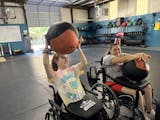Adaptive Fitness Myths
Adaptive fitness is often misunderstood, with misconceptions about the capabilities and training of adaptive athletes. Let’s break down five common myths and reveal the truth about this dynamic and powerful fitness community.
1. Myth: Adaptive Athletes Do Scaled-Down Versions of Able-Bodied Workouts
Busted: It’s a common belief that adaptive athletes only perform modified, easier versions of workouts done by able-bodied athletes. This couldn’t be further from the truth. In reality, adaptive athletes—especially those competing in WheelWOD and CrossFit competitions—take on grueling workouts that challenge their strength, endurance, and mental fortitude. Many of the movements adaptive athletes perform are so advanced and intense that even some able-bodied athletes would struggle to complete them. Adaptive fitness isn’t about scaling down; it’s about reimagining workouts for maximum performance within an athlete’s unique capabilities.
2. Myth: Adaptive Fitness Is Only for Rehabilitation
Busted: While adaptive fitness is incredibly valuable for rehabilitation, it goes far beyond just therapy. Adaptive athletes train to improve their performance, compete in high-level competitions, and push their physical limits just like any other athlete. From weightlifting to endurance events, adaptive fitness focuses on building strength, speed, and agility, making it a competitive and high-performance domain, not just a rehabilitative one.
3. Myth: Adaptive Fitness Equipment Is Limited and Ineffective
Busted: The adaptive fitness industry has seen tremendous innovation over the years. Companies like Equip Products have developed specialized equipment such as the Rowing Hook, Aldridge Arm, and Adaptive SkiErg Base to allow athletes of all abilities to perform complex movements effectively and efficiently. These tools are not only highly effective but are often specifically designed for elite performance, ensuring that adaptive athletes can train and compete at the highest levels.
4. Myth: Adaptive Athletes Are Limited by Their Impairments
Busted: This myth implies that adaptive athletes are held back by their physical limitations. In truth, adaptive athletes are constantly redefining what’s possible in the fitness world. From deadlifting hundreds of pounds to performing handstand push-ups, they prove that with the right mindset, tools, and training, limitations can be overcome. Adaptive athletes don’t see their impairments as obstacles—they see them as challenges to be met head-on.
5. Myth: Adaptive Fitness Only Caters to Specific Disabilities
Busted: Adaptive fitness is incredibly versatile and is designed to accommodate a wide range of abilities and impairments. Whether someone uses a wheelchair, has a prosthetic limb, or has a neurological condition, adaptive fitness provides the tools and modifications needed to create a personalized workout. The community and competitions, like those in CrossFit and WheelWOD, celebrate all kinds of abilities, focusing on what athletes can do, rather than what they can't.
By breaking down these myths, it's clear that adaptive fitness is about power, innovation, and pushing the limits of what’s possible. Athletes in this space continue to prove that adaptive fitness isn’t a scaled-down version of traditional workouts but a highly competitive, advanced, and inspiring movement in its own right.



